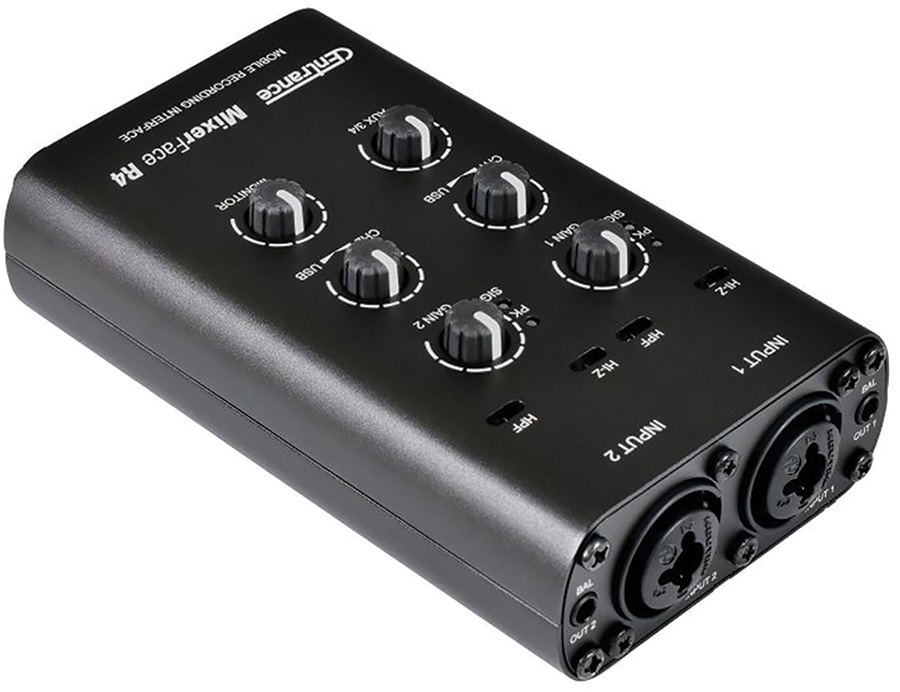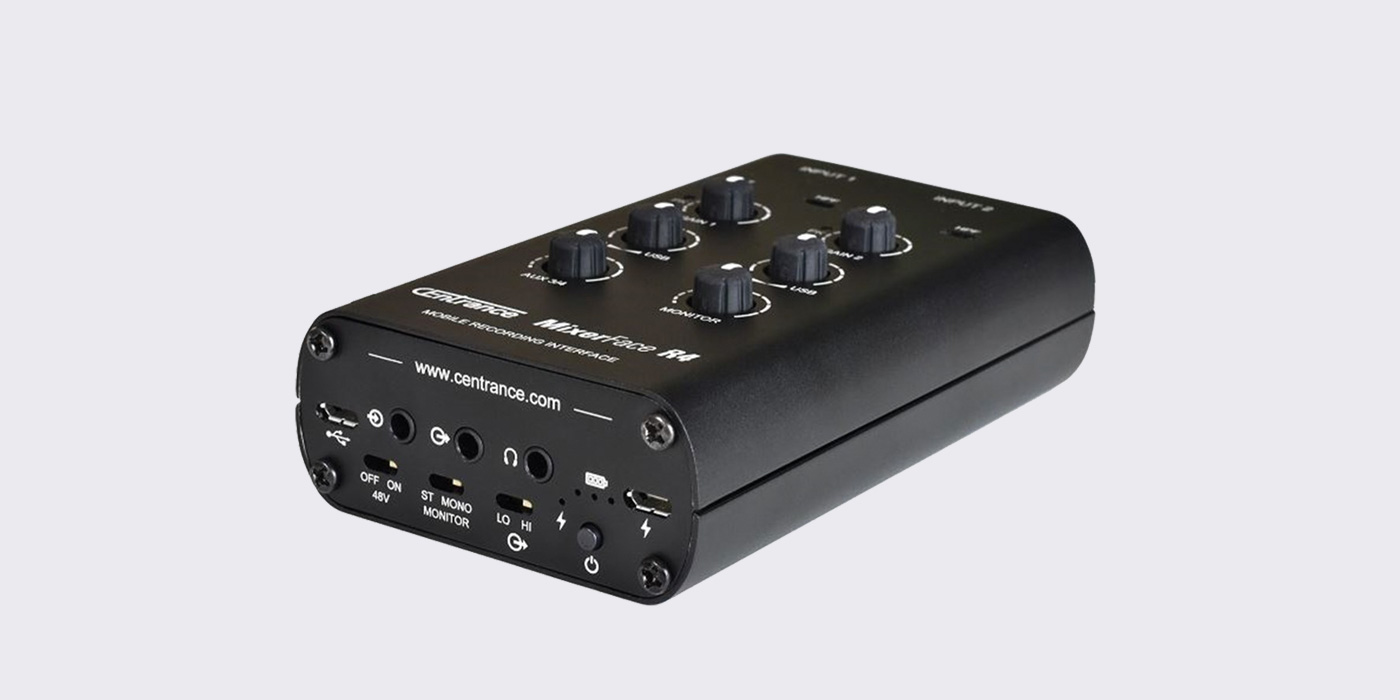More interface in less space than
you’ve ever seen before
Review by Mike Metlay
CEntrance might not be a firm that’s instantly familiar to recording musicians, but it’s been around for a good long time and has produced some truly groundbreaking interfaces. Just as one example: years and years before “guitar in/headphones out” USB interfaces were a common thing, the AxePort Pro offered great tone and monitoring in a compact and affordable package.
The new MixerFace R4 is another matter entirely. With this beautifully-designed and incredibly flexible little box, CEntrance has raised the bar on how many useful features can be crammed into a portable interface (sized to have about the same footprint as a medium-sized smartphone) without sacrificing sound quality.
Reviews
- Review: Chandler TG Microphone Type L
- July 2024: Strymon BigSky MX
- Review: Grace Design ROXi & REX
- Review: Genelec 8381A SAM™ Adaptive Point Source Main Monitor
- June 2024: Amphion One25A
- Review: Eventide Blackhole and MicroPitch Immersive
- May 2024: Ohma World Ribbon Microphone
- April 2024: Ableton Live 12
- March 2024: JZ Microphones BT202
- February 2024: JH Audio Pearl + Ruby
- February 2024: Antares Vocal Reverb by Auto-Tune
- January 2024: Ableton Push 3
Built for the road
The MixerFace R4 comes out of the box and immediately impresses the user with the feeling that it’s designed for hard use in the field as well as in studios, by folks who know what that entails. The matte-black aircraft aluminum chassis and overall build quality are reassuringly solid.
With the exception of the tiny power button, every single function switch is recessed to prevent accidental switching. They’re only accessible with a tool such as a jeweler’s screwdriver or the ever-useful bent paperclip. The pots have a low profile and enough of a taper to not snag on things. Rather than bristling with awkward connection points all over, its I/O is neatly laid out on the two ends of the box, making cable runs easy. CEntrance put a lot of thought into making the MixerFace R4 right rather than making it cheap.
Ins and outs and MORE ins and outs
 The MixerFace R4 I/O is optimized for field recording and mobile content creation. While its USB interface is a conventional 2-in/2-out design, the analog front end is quite a bit fancier, with four input channels mixed to stereo before recording and six output channels to route the stereo mix to multiple destinations.
The MixerFace R4 I/O is optimized for field recording and mobile content creation. While its USB interface is a conventional 2-in/2-out design, the analog front end is quite a bit fancier, with four input channels mixed to stereo before recording and six output channels to route the stereo mix to multiple destinations.
The front end of the unit has the balanced connections: two Neutrik Combo XLR/TRS jacks for mic and line-level signals, and two TRS minijacks for balanced line-level outputs. Note that those minis aren’t stereo, they’re true balanced outputs—it’s easy enough to obtain an adapter cable for this purpose, letting the MixerFace R4 interface with pro gear effortlessly.
The back end is just as crowded, with dual USB Micro-B ports for data and charging (charging? We’ll get to that in a moment), three TRS unbalanced stereo minijacks for the Aux 3/4 input, line-level stereo output, and headphone output. The bottom panel is also where you’ll find recessed switches for 48V phantom power (global, but it doesn’t affect the TRS inputs), mono/stereo monitoring, and low/high gain for the stereo line output—the former for direct connection to DSLR cameras and the latter for pro hookups.
In control
The top panel is neatly and logically laid out, with fully independent controls and indicators for the two mic/line inputs. Each input has a Hi-Z switch to record guitars or basses, a highpass filter (130 Hz corner frequency with 6 dB/octave slope, great for reducing wind noise), and a gain pot with signal-present and peak LEDs and a 55 dB gain range—perfect for condenser mics, active ribbons, and hotter dynamics, but you’ll want an external preamp for low-level dynamic mics and passive ribbons.
Each input has its own balance pot to blend the direct signal with the USB stereo feed coming back from your DAW. This novel addition is actually quite slick, letting you individually control how much of each input you want to hear at zero latency. Below that are the global stereo level controls for the Aux 3/4 input and the Monitor output. The Monitor knob controls the level of the balanced output pair and the headphones; the line-level stereo output’s level is fixed.
Charge it
The MixerFace R4 stands apart from the competition in another way, too: it sports a fairly hefty internal battery with a 3-LED charge indicator and dedicated USB charging port. Having internal juice might seem odd to someone used to working with laptop or desktop computers that can easily bus-power an interface, but folks who record in the field will recognize the benefits immediately!
Reliable power for portable interfaces can be a nightmare, especially if they’re attached to smartphones. They won’t power up at all, or work with reduced audio quality (especially when trying to supply phantom power), so the user has to figure out how to power them, adding cables and the potential for ground loop hum. Yuck.
With its battery handling the heavy lifting, the MixerFace R4 can do everything you need with minimal cabling. It takes 4 to 5 hours to charge all the way up, which provides a full 8 hours or more of hard use, including stable 48V phantom to your mics. You can leave it plugged in when using it at home, and it’ll talk to any macOS, iOS, or Android device as long as you have the right USB, Lightning, or OTG cable (Windows PCs require a free downloadable ASIO driver). It comes with a conventional USB-A cable for laptop use or to connect to a USB charger.
In use
As long as you remember to carry a paperclip with you, the MixerFace R4 is an absolute joy to work with. The preamps are clean and clear with no deliberate coloration, suitable for all kinds of input sources, and the Hi-Z inputs sound great with all but the most finicky piezo pickups. Monitor levels are nice and loud, and conversion is excellent as well, with reliable and noiseless operation at resolutions up to 24/192. It’s great to have pro-level sound to go with this unit’s pro-level build and feature set. Just pop it into its included soft drawstring carry bag and head out into the world!
One final note: just as we went to press, CEntrance rolled out the MixerFace R4R, a model with a built-in digital recorder that uses microSD cards, available alone or with an XY stereo mic that plugs right into the Combo jacks for a completely portable high-rez recording solution. We didn’t get a chance to try it out, but if the recorder function is as solid as what we’ve seen already, it will add even more flexibility and reliable redundancy to an already-exceptional field recording interface.
Prices: MixerFace R4, $349.99; MixerFace R4R, $449.99 ($499.99 with XY mic)
More from: CEntrance, www.centrance.com


